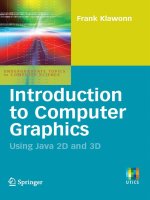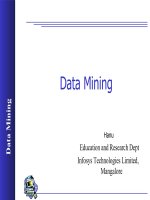datamining-intro-IEP
Bạn đang xem bản rút gọn của tài liệu. Xem và tải ngay bản đầy đủ của tài liệu tại đây (229.01 KB, 47 trang )
An Introduction to Data Mining
Prof. S. Sudarshan
CSE Dept, IIT Bombay
Most slides courtesy:
Prof. Sunita Sarawagi
School of IT, IIT Bombay
Why Data Mining
Credit ratings/targeted marketing:
Given a database of 100,000 names, which persons are the
least likely to default on their credit cards?
Identify likely responders to sales promotions
Fraud detection
Which types of transactions are likely to be fraudulent, given
the demographics and transactional history of a particular
customer?
Customer relationship management:
Which of my customers are likely to be the most loyal, and
which are most likely to leave for a competitor? :
Data Mining helps extract such
information
Data mining
Process of semi-automatically analyzing
large databases to find patterns that are:
valid: hold on new data with some certainity
novel: non-obvious to the system
useful: should be possible to act on the item
understandable: humans should be able to
interpret the pattern
Also known as Knowledge Discovery in
Databases (KDD)
Applications
Banking: loan/credit card approval
predict good customers based on old customers
Customer relationship management:
identify those who are likely to leave for a competitor.
Targeted marketing:
identify likely responders to promotions
Fraud detection: telecommunications, financial
transactions
from an online stream of event identify fraudulent events
Manufacturing and production:
automatically adjust knobs when process parameter changes
Applications (continued)
Medicine: disease outcome, effectiveness of
treatments
analyze patient disease history: find relationship
between diseases
Molecular/Pharmaceutical: identify new drugs
Scientific data analysis:
identify new galaxies by searching for sub clusters
Web site/store design and promotion:
find affinity of visitor to pages and modify layout
The KDD process
Problem fomulation
Data collection
subset data: sampling might hurt if highly skewed data
feature selection: principal component analysis, heuristic
search
Pre-processing: cleaning
name/address cleaning, different meanings (annual, yearly),
duplicate removal, supplying missing values
Transformation:
map complex objects e.g. time series data to features e.g.
frequency
Choosing mining task and mining method:
Result evaluation and Visualization:
Knowledge discovery is an iterative process
Relationship with other
fields
Overlaps with machine learning, statistics,
artificial intelligence, databases, visualization but
more stress on
scalability of number of features and instances
stress on algorithms and architectures whereas
foundations of methods and formulations provided by
statistics and machine learning.
automation for handling large, heterogeneous data
Some basic operations
Predictive:
Regression
Classification
Collaborative Filtering
Descriptive:
Clustering / similarity matching
Association rules and variants
Deviation detection
Classification
(Supervised learning)
Classification
Given old data about customers and
payments, predict new applicant’s loan
eligibility.
Age
Salary
Profession
Location
Customer type
Previous
customers
Classifie
r
Decision rules
Salary > 5 L
Prof. = Exec
New applicant’s
data
Good/
bad
Classification methods
Goal: Predict class Ci = f(x1, x2, .. Xn)
Regression: (linear or any other polynomial)
a*x1 + b*x2 + c = Ci.
Nearest neighour
Decision tree classifier: divide decision space
into piecewise constant regions.
Probabilistic/generative models
Neural networks: partition by non-linear
boundaries
Define proximity between instances, find
neighbors of new instance and assign
majority class
Case based reasoning: when attributes
are more complicated than real-valued.
Nearest neighbor
•
Cons
–
Slow during application.
–
No feature selection.
–
Notion of proximity vague
•
Pros
+
Fast training
Tree where internal nodes are simple
decision rules on one or more attributes
and leaf nodes are predicted class labels.
Decision trees
Salary < 1 M
Prof = teacher
Good
Age < 30
BadBad
Good
Decision tree classifiers
Widely used learning method
Easy to interpret: can be re-represented as if-
then-else rules
Approximates function by piece wise constant
regions
Does not require any prior knowledge of data
distribution, works well on noisy data.
Has been applied to:
classify medical patients based on the disease,
equipment malfunction by cause,
loan applicant by likelihood of payment.
Pros and Cons of decision
trees
·
Cons
-
Cannot handle complicated
relationship between features
-
simple decision boundaries
-
problems with lots of missing
data
·
Pros
+
Reasonable training
time
+
Fast application
+
Easy to interpret
+
Easy to implement
+
Can handle large
number of features
More information:
/>
Neural network
Set of nodes connected by directed
weighted edges
Hidden nodes
Output nodes
x1
x2
x3
x1
x2
x3
w1
w2
w3
y
n
i
ii
e
y
xwo
−
=
+
=
=
∑
1
1
)(
)(
1
σ
σ
Basic NN
unit
A more typical
NN
Neural networks
Useful for learning complex data like
handwriting, speech and image
recognition
Neural networkClassification tree
Decision boundaries:
Linear regression
Pros and Cons of Neural
Network
·
Cons
-
Slow training time
-
Hard to interpret
-
Hard to implement: trial
and error for choosing
number of nodes
·
Pros
+
Can learn more complicated
class boundaries
+
Fast application
+
Can handle large number of
features
Conclusion: Use neural nets only if
decision-trees/NN fail.









